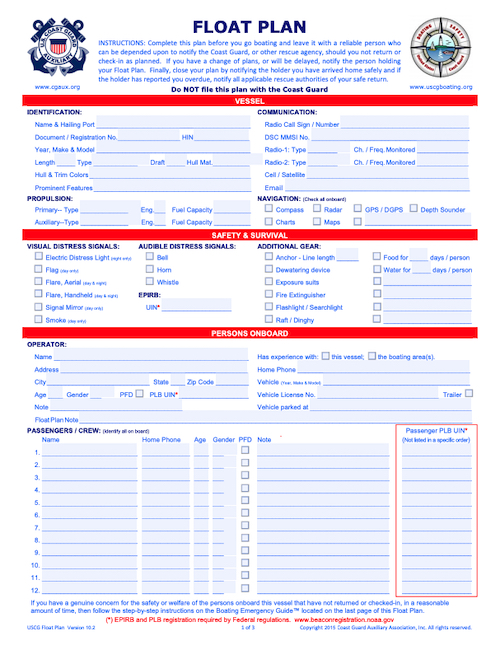All Articles
Boat Handling & Seamanship
Enjoying Your Day, Comfortably
Maintenance
Fishing
Dining Aboard
Trailering
Personal Touches
Performance & Efficiency
Ports of Call & Places to Anchor
All Years
2025
2024
2023
2022
2021
2020
2019
2018
2017
2016
2015
What Should Be Included on a Float Plan?

Pilots file a flight plan before each takeoff for general safety and to facilitate possible search-and-rescue operations should they be needed. For the same reasons, boaters should file a float plan, which is the best preparation for a boating emergency.
What is a Float Plan?
A float plan is an overview of a boat excursion that can give authorities a head start in looking for a boater if he or she fails to reach his or her destination.
A float plan document should include:
- Description of the vessel
- Number of persons onboard
- Destination, including the general route to be taken
- Contact information
- Timeframe of the outing
A float plan can be created by anyone whether heading down the river on a personal watercraft (PWC), going kayak fishing along the coast, or doing serious offshore sailing. Details to be included vary but the more specific the plan, the better.
- Vessel information should include size, color, make, type of boat, size of engine if any, and a vessel identification number.
- Consider adding information such as the name and location of the marina or launch ramp where you started.
- Add your vehicle’s (or the tow vehicle’s) location and license plate number.
- Include the names of all aboard and their ages, genders and any medical conditions or pertinent disabilities.
- Describe the intended itinerary in detail and provide multiple points of contact for those aboard including cell phones, VHF radio (if available) and even home addresses. Focus on key places and times you will check in or when you plan to return.
How & Where Do You File a Float Plan?
A detailed float plan should be left with a family member, a reliable friend, a marina dock master or anyone else you trust to contact the US Coast Guard in case of an emergency. Don’t file a float plan directly with the US Coast Guard.
File the plan before you depart—the more time you allow prior to leaving, the better organized you and others will be. If your plans change due to weather, mechanical issues, or even personal preferences, reach out to your contact and update them or risk launching an expensive rescue mission even if you’re still in the slip.
Where Do You Get the Forms to Create a Float Plan?
There are numerous resources that can guide you in creating a hardcopy float plan or even provide an online form to complete. One of the most comprehensive forms can be found at USCG Auxiliary Float Plan. Notice that this form clearly states that your float plan is NOT to be filed with the Coast Guard but rather with someone you trust to contact the Coast Guard if you cannot be reached directly. Page 3 even guides your contact person as to the steps to be taken to notify authorities.
Other places you can find float plan forms include an on-water assistance organization like a boat towing company (BoatUS or SeaTow, for example) or your state’s boating and waterways department website. The USCG Auxiliary also offers an app.
What Are My Responsibilities When I File a Float Plan?
Float plans don’t need to be formal. If you’re heading out to anchor in a favorite cove for the weekend, you can jot down when you’re going, where, with whom and when you expect to be back.
If you tell your contact person that you’ll call them when you arrive at the cove or when you get back home—do so. Don’t head to dinner and forget. You may know you’re safe but the person you entrusted with your potential rescue doesn’t. Close out a float plan when you’re done with your excursion by notifying your contact that your outing is complete and that you’re safe. Never leave a float plan open.
A float plan is a boater’s safety plan. It’s a bit of insurance and peace-of-mind that if you find trouble out on the water, someone will find you.
